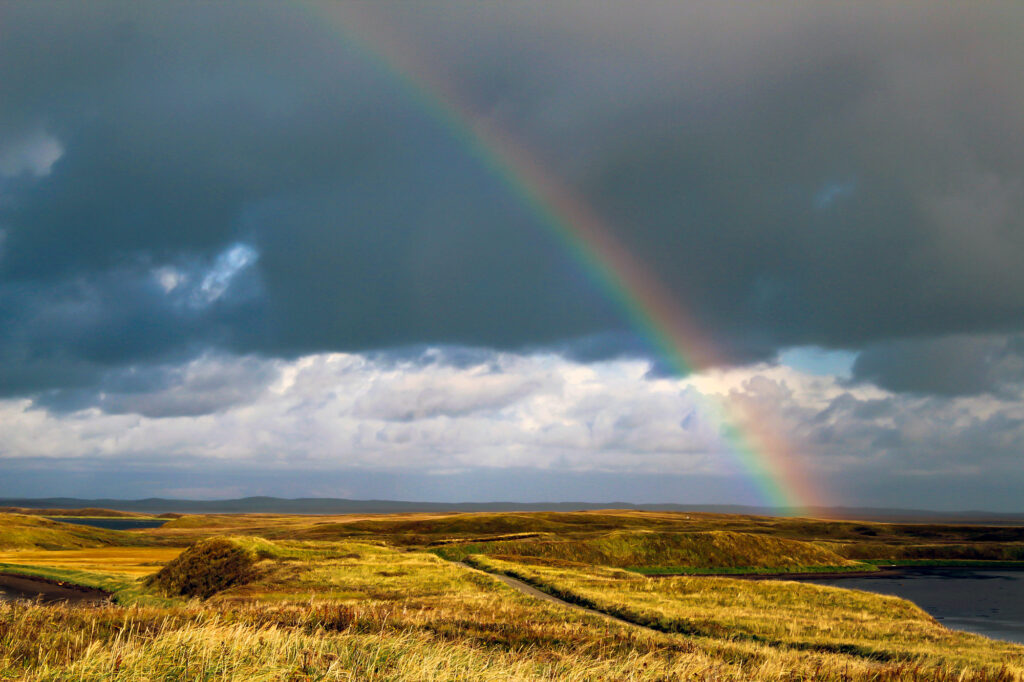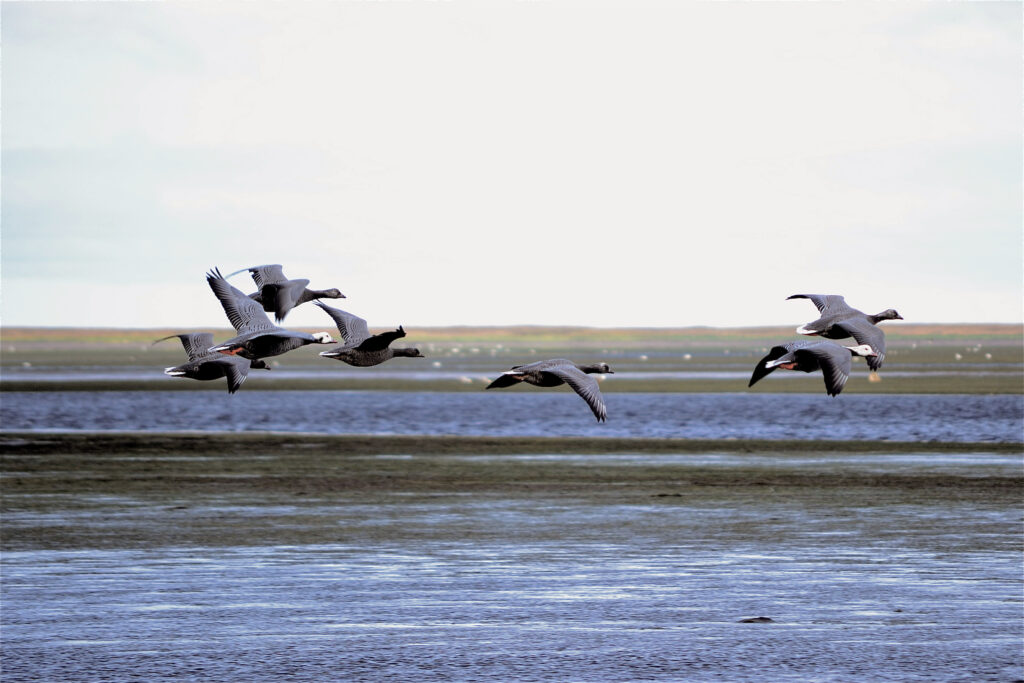National Wildlife Refuge Week: The Meaning of Refuge

Header Image: A rainbow arcs over Izembek National Wildlife Refuge. Credit: Rebecca Fabbri/USFWS.
The term “refuge” evokes powerful imagery: safety, shelter from harm, and a place where life can thrive without interference. National Wildlife Refuges, managed by the U.S. Fish and Wildlife Service (USFWS), are designed to embody this concept, providing protection for wildlife, their habitats, and the communities that depend on the resources of the land.
However, when we reflect on the idea of a refuge, a troubling question often comes up: Why are some of these places at the center of constant threat? While refuges across the U.S. encounter challenges, Alaska’s are particularly vulnerable due to the state’s vast oil reserves and shifting political priorities. Alaska is home to some of the most significant wildlife refuges, including Izembek, Kenai, and the Arctic National Wildlife Refuge. Intended as sanctuaries, these lands face mounting political, economic, and environmental pressures. Resource extraction—such as oil drilling and mining—and exploitation undermine the very essence of what a refuge represents.
As we celebrate National Wildlife Refuge Week, we must recognize not only the importance of these places but also the ongoing fight to protect them. Alaska’s refuges serve as a reminder that the promise of safety and shelter is only as strong as the commitment to defending it.
The Smallest (but mightiest) Refuge in Alaska: Izembek National Wildlife Refuge
Izembek National Wildlife Refuge is located on the Alaska Peninsula and spans over 310,000 acres of wetlands, lagoons, and tundra. Though it may be Alaska’s smallest National Wildlife Refuge, it stands as one of the most ecologically unique and vital areas in the state.

Photo by K.Mueller/USFWS
At its heart lies the Izembek Lagoon, recognized as a Wetland of International Importance under the RAMSAR Convention. This lagoon hosts one of the world’s largest beds of eelgrass, providing critical feeding and resting areas for millions of migratory birds. Each spring and fall, thousands of emperor geese migrate through Izembek, making it a key stopover site along their migratory routes.
Over 200 species of wildlife and nine fish species thrive in the refuge. The Southern Alaska Peninsula caribou herd migrates here in late fall, while during peak salmon runs, up to nine brown bears can be spotted per mile along the streams. Year-round, tundra swans reside in the area, and thousands of gray, minke, and killer whales migrate along the coast.
Yet, Izembek faces constant threats from a proposed land exchange that would enable the construction of a road connecting the villages of King Cove and Cold Bay. Such development would fragment one of the most biologically rich wetlands on the planet, endangering wildlife and setting a dangerous precedent for the management of protected areas.
The proposed road would slice through the federally designated Izembek Wilderness, causing irreversible damage to the ecosystem. After a three-year study, the Obama administration’s USFWS concluded that the road was unnecessary and harmful, emphasizing that it would irreparably impact crucial wetlands for migratory waterfowl and other species.
Despite this clear and scientifically backed opposition, the Trump administration’s Department of the Interior made repeated attempts to push through a land swap for road construction. Fortunately, court rulings recognized the potential harm and rejected these attempts. However, in 2021, the Biden administration’s Department of Justice defended a legal brief that reopened the possibility of a land exchange.
Moving forward with this exchange risks the integrity of all of Alaska’s conservation system units by opening the door to future land exchanges for commercial and private purposes.
“Alaska in Miniature”: Kenai National Wildlife Refuge

Credit: Lisa Hupp/USFWS
Referred to as “Alaska in Miniature,” Kenai National Wildlife Refuge is far from a mini-Lego set replica of Alaska. Spanning 2 million acres just south of Anchorage, its diverse habitats—from coastal wetlands to alpine tundra—are home to a classic roster of Alaskan wildlife, including moose, brown and black bears, caribou, and wolves. It’s not just a refuge for animals but a recreation spot for those who enjoy Alaska through fishing, hiking, wildlife viewing, and hunting.
However, recent attempts to expand dangerous practices like bear baiting and trapping within Kenai threaten to dismantle the very concept of a wildlife refuge. Bear baiting, a method where food is used to lure bears for easy hunting, not only disrupts natural bear behaviors but also puts both humans and bears at risk by increasing dangerous interactions. The idea that such practices are even considered in a place where people recreate is wildly irresponsible and unethical.
The USFWS has made it clear that these activities directly contradict the refuge’s mission to conserve wildlife populations and maintain ecological balance. Yet, under the Trump administration, regulations were pushed to allow these harmful practices. Fortunately, the plan was withdrawn under the Biden administration in 2023, sparing the refuge from further Trump administration degradation.
Kenai’s proximity to major population centers and its role as a wildlife refuge and recreational space makes it essential to protect it from reckless exploitation. Feeding bears where you recreate? It sounds absurd, but apparently not to those who would rather cater to a narrow set of interests.
The Last Wild Place on Earth: Arctic National Wildlife Refuge
The Arctic Refuge is perhaps the most iconic of all Alaska’s wildlife refuges. Spanning more than 19 million acres, it’s one of the largest and most remote wildlife refuges in the world, representing one of the last truly wild places on Earth.

Photo Credit: Danielle Brigida/ USFWS
The Arctic Refuge supports a wide range of species, including polar bears, wolves, muskoxen, and the Porcupine caribou herd. The survival of this caribou herd is intricately tied to the cultural and subsistence traditions of the Gwich’in people, an Indigenous group who have lived in the region for thousands of years. The Gwich’in refer to the coastal plain of the Refuge as “the sacred place where life begins,” because it serves as the primary calving grounds for the Porcupine caribou herd. This area is crucial for the caribou’s survival and, by extension, the Gwich’in way of life, as the caribou provide food, clothing, and tools essential to their culture. For decades, the Arctic Refuge has been at the center of political battles over oil and gas development. Drilling in the Arctic Refuge poses enormous risks to the ecosystem, including potential oil spills, habitat destruction, and disruptions to the migration patterns of caribou and other wildlife.
The Trump administration’s 2017 Tax Cuts and Jobs Act recklessly opened the door for oil exploration in the refuge, under the guise of economic benefit. This act is the only legislation to mandate drilling within a wildlife refuge, adding oil and gas development as a purpose which is not only unprecedented but antithetical to the purpose of a refuge. Framing the Arctic Refuge as an oil resource is a gross misrepresentation of the importance of the land not only for wildlife, but for the Gwich’in people who lived and cared for this land long before its designation.
Defending the Meaning of Refuge
As we celebrate National Wildlife Refuge Week, we acknowledge that the fight to protect these lands is far from over. The history of Alaska’s wildlife refuges has been one of constant conflict between exploitation and preservation, with each administration’s policies either chipping away at or reinforcing their integrity.
These refuges are more than just protected spaces—they are homes to countless species, and essential to the cultural and spiritual being of Indigenous communities. They offer us a glimpse into a world that is increasingly vanishing due to human development and climate change, while reminding us of what we stand to lose if we fail to defend them—the wildlife, the people, and the lands themselves.
“Refuge” must mean what it implies: safety, sanctuary, and protection. We cannot afford complacency.
